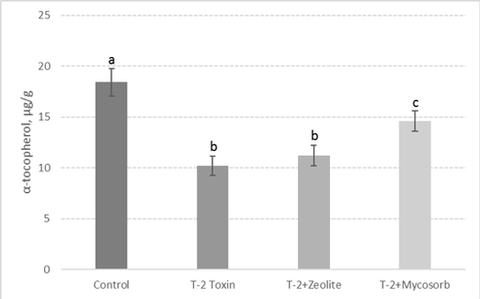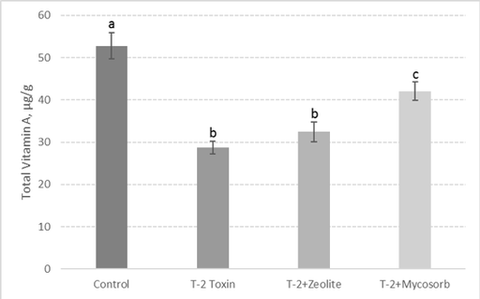



Mycosorb reduces effect of T-2 toxin in quail diets
(2001)
Researchers at Scottish Agricultural College (Dvorska and Surai, 2001) showed that Mycosorb could significantly inhibit the dietary effect of T-2 toxin on growing quail fed a corn-based diet.
Split into four groups of 20, four-day-old quail were fed corn-based diets with added Fusarium sporotrichioides for 30 days to generate 8.1 mg/kg T-2 toxin levels.
Zeolite (a clay-based additive) and Mycosorb (a yeast-based additive) were fed during the T-2 challenge; both products are designed to bind mycotoxins during digestion to reduce toxin levels.
Zeolite was fed at 30 g/kg (3 percent) with added T-2, whereas Mycosorb was fed at 1 g/kg (0.1 percent) with added T-2 toxin. Along with a control group that received no adsorbents or T-2, a second group received added T-2 and no adsorbents.
The presence of T-2 toxin significantly reduced antioxidant concentrations in quail liver samples. For instance, vitamin E (α-tocopherol) was reduced by almost 50 percent.
Quail fed with Zeolite still exhibited antioxidant depletion, while the quail fed with Mycosorb showed improvement, with an increase in α-tocopherol and ascorbic acid.
Antioxidant suppression may be one cause for the increase in lipid peroxidation (MDA) observed with the presence of T-2 toxin. Oxidative stress can lead to cell damage and other downstream effects. Mycosorb was the only additive that significantly reduced MDA levels during the T-2 challenge.
In comparison to Zeolite, Mycosorb also significantly increased vitamin A levels in liver samples, counteracting the negative effects of T-2.
READ FULL PAPER

Figure 1:
Concentration of vitamin E (α-tocopherol) in quail liver, µg/g (Dvorska and Surai, 2001)
Figure 2:
Concentration of total vitamin A in quail liver, µg/g (Dvorska and Surai, 2001)

Esterified Glucomannan (EG) counters decrease in fertility for rams with Aflatoxin contamination.
(2013)
While silage production is a good way to extend forage as a feed source, poor management leaves livestock at risk of aflatoxin (AF) contamination. Along with a decrease in fertility, AF in ruminants has been linked to weight and production losses, abortion, hepatotoxicosis and immunosuppression.
Researchers at multiple universities in Turkey collaborated on a research trial to determine the effect of AF on spermatologic, biochemical and testis parameters in rams, and to learn if esterified glucomannan (EG) would discourage AF damage. Mycosorb A+® was used throughout the trial as the EG additive.
After a 15-day transition period, 32 Merino rams, ranging from 12 to 14 months of age, were individually weighed and split into four groups of eight.
During the course of the 92-day trial, rams received ad-lib water and alfalfa, along with 250 g of commercial feed with certain additives included based on their group. A control group received no additives, the second group received 250 mg/d of total AF, the third group received 250 mg/d of total AF with 2 g/d of EG, and the last group was given 2 g/d of EG.
Twice a week for 12 weeks, semen was collected and analysed for sperm motility, morphology and viability. At the end of the 92 days, the testes were removed from the rams and weighed, after which tissue samples were collected.
During the first two weeks of the study, the spermatological parameters remained unchanged for all the test groups. However, from week three to the end of week 12, dead sperm counts in the AF group were greatest. Rams receiving the combination of AF and EG significantly improved AF-induced damage, improving rates of sperm motility. Compared to the control group, the incorporation of EG into feed alone did not induce any major effect.
Rams in the control group and rams supplemented only with EG maintained the regular structure of teste spermatogenic lines and seminiferous tubules. A histological examination of testes from rams fed a combination of AF and EG showed a slightly altered but, overall, regular structure. However, rams fed AF exhibited a decrease in spermatogenic cells in the spermatogenic lines.
READ FULL PAPER
New Research Roundup
Mycosorb A+® significantly reduces ZEA in pigs
The results of studies exploring zearalenone (ZEA) uptake in the digestive tract of swine showed that adding Mycosorb A+® to a feed mixture containing ZEA significantly reduced the accumulation of ZEA after five weeks.
The Research:
Zearalenone and metabolite uptake modulation by feeding Mycosorb A+® to growing pigs
A. Yiannikouris1, C. A. Moran2, J.D. Keegan3, P. Groenewegen1*, K. Vienola4 and J. Apajalahti4.
1Center for Animal Nutrigenomics and Applied Animal Nutrition, Alltech Inc., Nicholasville, Kentucky, USA, 2Alltech SARL, Vire, France, 3Alltech European Bioscience Centre, Ireland, 4Alimetrics, Espoo, Finland.
Studies were carried out in a swine model in order to understand the distribution of the mycotoxin zearalenone (ZEA) and one of its phase I metabolites, α-zearalenol (α-ZOL), along the digestive tract and in the feces of pigs following ingestion of ZEA at 200 μg/kg feed.
At the same time, the administration of ZEA in feed fortified with 4 kg/T Mycosorb A+® (MSA+) was evaluated to test if MSA+ would increase the ZEA/α-ZOL recoveries in feces and, consequently, decrease the ZEA uptake in the digestive tract.
Experimental diets included a commercial pig feed base diet (F0); the base feed altered with ZEA (F1); and the base feed fortified with a combination of ZEA and MSA+ (F2). All feeds contained a digestibility marker (Celite™) and 10 percent cracked wheat.
Individually-housed pigs (n=12) were given F0 over a one-week adaptation period, followed by four weeks during which half of the pigs (n=6) were randomly assigned either to F1 or F2 treatments.
At the end of the study, four pigs from each treatment were sacrificed, and the remaining pigs underwent a two-week washout period using F0 before being sacrificed. Fecal samples were taken biweekly and reproductive tract samples were taken at the end of treatment or wash-out.
ZEA and α-ZOL quantitative analysis was performed using immunoaffinity extraction before separation on a RP-C18 HPLC system equipped with fluorescent detection. The amount of ZEA recovered in feces vs. added in the diet was calculated.
Results showed that animals receiving the F2 regimen exhibited significantly higher (p<0.0001) concentration of both ZEA and α-ZOL in feces compared to F1 challenged pigs (30.5 vs 54.7 percent at 4 weeks). MSA+ significantly reduced the accumulation of ZEA (77 vs 15 μg/kg) and ZEA+α-ZOL (89 vs 17 μg/kg) in the reproductive tract after five weeks.
These results indicate that MSA+ successfully decreased ZEA uptake and metabolization while also increasing digestive clearance of ZEA via feces.
Mycotoxin effect on cattle alleviated by Yeast-Derived Adsorbent
A study into the effect of mycotoxins on the performance of Nellore cattle finishing in feedlot, using both natural contamination and exogenous contamination methods, has shown that Yeast-Derived Adsorbent (YDA) can help alleviate negative results in the carcass weight and dressing percentages of the animals.
The Research:
Do mycotoxin-contaminated diets and yeast-derived adsorbent affect finishing Nellore cattle performance in feedlot?
Leticia Custodio1, Laura F. Prados2, Alexandros Yiannikouris3, Danubia N. Figueira1, Eduardo M. da Gloria4, Vaughn B Holder5, James E. Pettigrew6, Leandro N. Kuritza7, Flávio D. de Resende2and Gustavo R. Siqueira2
The objective of the study was to evaluate the effect of mycotoxins and yeast-derived adsorbent on the performance of Nellore cattle finishing in feedlot. One hundred Nellore cattle (430±1.0 kg and 24 mo) were used. At the beginning of the experiment, four randomly selected animals were slaughtered to determine the initial hot carcass weight (HCW).
The experiment was conducted in a 2×2 factorial arrangement of treatments, consisting of two diets with natural contamination (NC) or exogenous contamination (EC) and the presence (10 g/hd/day) or absence of yeast-derived adsorbent (YDA).
The diets with NC and EC had the following contamination levels: aflatoxin 0 and 10 µg/kg, fumonisin 5,114 and 5,754 µg/kg, trichothecenes B 0 and 42.1 µg/kg, trichothecenes A 0 and 22.1 µg/kg, fusaric acid 42.9 and 42.9 µg/kg and REQ 15 and 45 µg/kg, respectively.
REQ is the risk equivalency quantity expressed in µg/kg of AFB1-equivalent, which is mycotoxin concentration interpretation according to known species-specific sensitivities, normalized according to the principles of toxic equivalent factors.
After 97 days of the experiment, the remaining animals were slaughtered and the HCW was obtained for determination of the carcass gain. There were no main effects or interactions of treatment factors for final weights (P = 0.40; 597, 592, 581 and 586 kg for NC, NC+YDA, EC and EC+YDA, respectively), DMI (P = 0.92; 12.7, 12.6, 12.0 and 12.0 kg, respectively) or ADG (P = 0.37; 1.72, 1.67, 1.56 and 1.62 kg, respectively).
However, there were interactions between factors for carcass gain (P < 0.08; 1.20, 1.14, 1.05 and 1.12, respectively) and for dressing (P < 0.04; 57.2, 56.6, 56.2 and 56.8, respectively), as a detrimental effect of EC was partially counteracted by YDA.
In conclusion, mycotoxins reduce the carcass gain and dressing percentage of the animals, while the yeast-derived adsorbent alleviates this damage.


